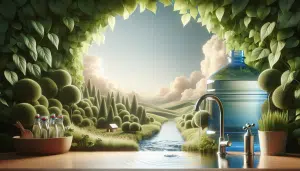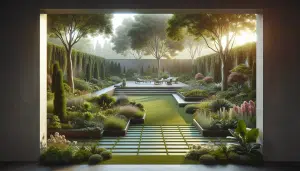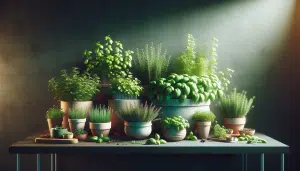Smart Ways You Transform Small Yards Into Inviting Spaces
Lily Carter October 26, 2025
If you think compact outdoor spaces can’t be both beautiful and functional, think again. This guide explores creative, practical ideas for small yard landscaping to help you maximize every inch, improve curb appeal, and enjoy your home environment more fully—no matter the size.
Understanding the Unique Advantages of Small Yards
Many homeowners perceive small yards as limiting, but these compact spaces provide several unique advantages. Small yard landscaping is more budget-friendly, requiring less material and maintenance. This allows for higher-quality plants and decorative finishes within the same financial scope as a large property, translating into noticeable upgrades. Watering, weeding, and fertilizing also take less time, supporting a sustainable approach to gardening. Embracing a small space means focusing on intentional design rather than overwhelming expanses, which can encourage creativity and efficient use of available land.
With the right techniques, a small yard can become an intimate retreat. Small backyards often offer increased privacy compared to open, expansive properties. Fencing or hedges can easily enclose the space, making it feel like a secluded oasis. Vertical gardening methods, container displays, and hanging planters further utilize every bit of available room without causing clutter. This helps to create distinct areas for relaxation or socializing even within minimal dimensions, as compact design naturally brings outdoor living spaces closer to home entryways and windows.
Maximizing a small yard often leads to more personal and impactful choices. Homeowners tend to invest more thought into selecting plants, creating focal points, and choosing outdoor furniture that fits the space perfectly. This personalized approach results in unique, memorable outdoor environments that reflect the tastes and needs of those who live there. Whether you prioritize a lush cottage garden, sleek modern patio, or a practical space for children and pets, every detail can matter more—inspiring both visual appeal and everyday enjoyment.
Strategic Planning: Layout Ideas for Small Outdoor Spaces
Success with small yard landscaping often depends on developing a clear strategy before the first plant or pathway is added. Begin by assessing your space’s existing features—sun exposure, shade patterns, and soil quality. Sketching a scaled blueprint can help visualize potential layouts and ensure every area serves a purpose. Many designers recommend segmenting a small yard into defined zones, such as dining, lounging, or gardening areas, to give the illusion of abundance. Each section offers unique functionality, contributing to an inviting, practical whole.
Smart design for small spaces also means considering sightlines. Placing taller plants or trellises at the edge draws the eye outward, making the area feel larger. Curved pathways or asymmetrical layouts can disrupt the feeling of a boxy lot, while staggered hardscape elements—such as stepping stones or patio tiles—add visual depth. Incorporating mirrors, reflective surfaces, or water features enhances brightness and the perception of space, turning even the smallest lot into an expansive-feeling retreat.
Selections for seating and built-in storage play a crucial role in maximizing space. Foldable or stackable chairs, benches with storage compartments, and slim-profile tables allow for flexible, clutter-free layouts. Multi-purpose furnishings can be easily adjusted when hosting guests or enjoying quiet moments outside, keeping the yard practical without sacrificing aesthetics. Strategic lighting, such as string lights or low-level lanterns, further defines cozy corners after sunset, extending the usability of the outdoor space during every season.
Plant Selection and Vertical Gardening Techniques
When choosing plants for a small yard, versatility and scale are key considerations. Opting for dwarf or compact varieties of trees, shrubs, and perennials can deliver lush foliage and blooms without overwhelming your outdoor environment. Native plants are often lower maintenance and more resilient to local conditions, encouraging pollinators and enhancing biodiversity. Position statement plants at focal points and surround them with ground covers or low-growing flowers to maximize visual richness in a small footprint.
Vertical gardening unlocks additional green potential in small yards. Installing trellises, lattice panels, or wall-mounted planters supports lush displays of vines, cascading flowers, or even vegetables. Climbing species such as clematis or morning glory add height and drama, distracting from limited ground space. Vertical herb gardens are also popular for blending functionality and style, providing fresh ingredients for the kitchen within easy reach and freeing up patio or pathway room below.
Containers make it possible to cultivate a wide variety of plants even on paved patios. Groupings of different pot sizes can create eye-catching arrangements and offer easy mobility for adapting layouts as seasons or preferences change. Raised beds, window boxes, and pocket planters on fences further expand growing space and allow experimentation with new plant combinations. These flexible strategies turn walls and corners into productive, decorative features year-round.
Smart Solutions for Privacy and Screening
Privacy is a frequent concern in urban or tightly clustered neighborhoods. Small yard landscaping for privacy can be achieved using living screens. Evergreen shrubs, bamboo, or tall ornamental grasses create a natural barrier that buffers noise and blocks unsightly views. Mixing plant heights in a tiered arrangement offers attractive layering and year-round coverage, making boundaries feel lush instead of stark or confining.
Fencing remains a classic solution for enclosing a yard and defining the property line, but modern options provide more than just security. Louvered wood panels, slatted metal structures, or recycled-material screens introduce architectural interest as well as privacy. Vertical plantings can soften hard surfaces, combining the protective qualities of a fence with the beauty of greenery. For renters or those on a budget, portable screens or outdoor curtains offer temporary options that adapt as needs change.
Clever use of outdoor art, weather-resistant textiles, or upcycled shutters adds further privacy and style. Incorporating water features or rustling plants, like bamboo or fountain grass, introduces soothing sounds that distract from neighboring activity. These sensory barriers foster a sense of seclusion, transforming compact yards into tranquil extensions of the living space. Mindful landscaping choices can make even exposed areas feel calm and private.
Low-Maintenance and Eco-Friendly Landscaping Tips
For many homeowners, the goal is to create a beautiful yard that won’t require constant upkeep. Low-maintenance landscaping begins with plant selection—favoring drought-tolerant, native, or slow-growing species limits watering and pruning needs. Mulching garden beds helps retain moisture, suppresses weeds, and improves soil health, promoting sustainability for the entire yard. Drip irrigation systems or rain barrels conserve water and ensure efficient distribution directly to roots, saving time and resources.
Eco-friendly hardscaping can be both stylish and sustainable. Choose locally sourced stone, permeable pavers, or recycled materials for patios and walkways to reduce environmental impact. Rain gardens or bioswales naturally manage stormwater and attract beneficial insects and birds, supporting local ecosystems. Compost bins or worm farms process yard waste into nutrient-rich soil amendments, closing the loop on sustainability within your own yard.
Seasonal care tasks—such as deadheading flowers or refreshing mulch—can be managed in just a few minutes each week in smaller spaces. Integrated pest management encourages beneficial insects and reduces the reliance on synthetic chemicals. These practices make gardens friendlier for families and pets as well. Overall, low-maintenance design allows residents to enjoy the beauty and function of their outdoor spaces while contributing positively to their community and environment.
Functional Design: Creating Zones for Relaxation and Entertainment
Small yards can be remarkably versatile with clever zone planning. Creating separate areas for lounging, dining, or play requires only modest shifts in furniture, surfacing, or decor. Outdoor rugs, container gardens, or a change in paving instantly indicate different spaces. Designing flow between these zones enhances comfort for daily use and accommodates guests during gatherings. Each zone becomes a destination, maximizing enjoyment within compact footprints.
Outdoor kitchens, fire pits, or portable grills bring functionality to dining spaces, encouraging more meals outdoors. Built-in benches, low café tables, or folding chairs allow for quick transitions between quiet relaxation and lively events. Shaded pergolas or retractable awnings expand the usability of the space, making it comfortable on hot days or during light showers. Integrating lighting, such as lanterns or solar-powered stakes, keeps entertainment possibilities open into the evening.
Creative storage solutions help maintain a clutter-free look and feel, which is essential in confined yards. Benches with concealed compartments, wall-hung tool racks, and weatherproof storage boxes all keep outdoor essentials organized and out of sight. This not only makes entertaining easier, but also extends the lifespan of outdoor accessories. By focusing on function as well as style, small yard designs foster inviting environments for relaxation, cooking, gardening, or play all year round.
References
1. National Gardening Association. (n.d.). Small Space Gardening. Retrieved from https://garden.org/learn/articles/view/3718/
2. University of Illinois Extension. (n.d.). Gardening in Small Spaces. Retrieved from https://extension.illinois.edu/containers/small-spaces.cfm
3. American Society of Landscape Architects. (n.d.). Home Landscape Design: Small Spaces. Retrieved from https://www.asla.org/sustainablelandscapes/small_spaces.html
4. Royal Horticultural Society. (n.d.). Small Gardens. Retrieved from https://www.rhs.org.uk/garden-design/garden-types/small-gardens
5. United States Environmental Protection Agency. (n.d.). Green Landscaping: Greenacres. Retrieved from https://www.epa.gov/greenacres
6. Cornell Cooperative Extension. (n.d.). Vertical Gardening. Retrieved from https://ccesuffolk.org/gardening/vertical-gardening







